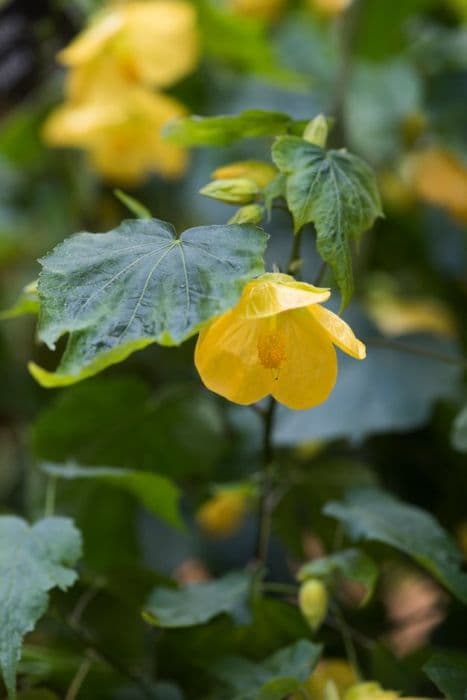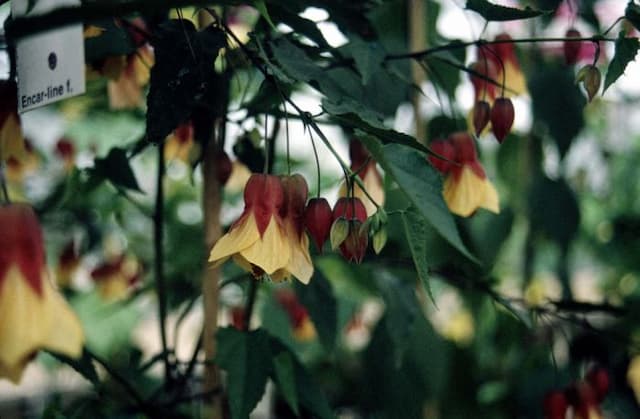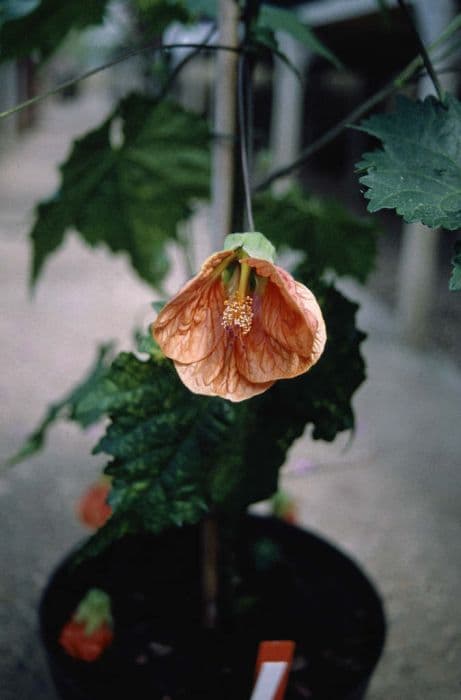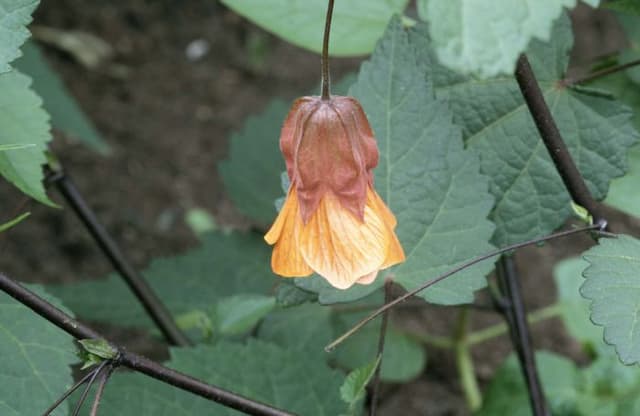Rose of Sharon Hibiscus syriacus 'Jeanne d'Arc' (d)

ABOUT
The Hibiscus syriacus 'Jeanne d'Arc', commonly known as the Rose of Sharon, is adorned with beautiful, large white flowers. Each bloom has a distinctive, ruffled appearance, giving it a classic and romantic look. The petals are pure white and sometimes can exhibit a slight hint of pink, adding to their charm. At the center, there's a contrasting deep red to burgundy throat, which amplifies the visual appeal of the flowers. This plant typically blooms profusely in the late summer, providing a spectacular display of color when many other plants have finished their flowering season. The foliage of the Rose of Sharon 'Jeanne d'Arc' is also noteworthy. The leaves are broad and have a medium green hue, making a lovely backdrop for the flowers. They have a somewhat glossy texture and a slightly toothed edge. The overall shape of the leaves can range from heart-shaped to three-lobed. This ornamental shrub maintains a bushy and upright form. Its branches are slender, and they grow in a somewhat vase-shaped pattern, which adds to the plant's architectural interest even when it is not in bloom. The wood is firm and offers good support for the plentiful flowers. With its romantic blossoms and attractive foliage, the Rose of Sharon 'Jeanne d'Arc' is a captivating addition to any garden, bringing elegance and a sense of serenity to the landscape. It is a beloved choice among gardeners looking for reliable summer color and a graceful plant structure.
About this plant
 Names
NamesFamily
Malvaceae.
Synonyms
Rose Of Sharon, Shrub Althea, Syrian Ketmia, Rose Mallow.
Common names
Hibiscus syriacus 'Jeanne d'Arc'.
 Toxicity
ToxicityTo humans
Rose of Sharon is considered to have a low toxicity level for humans. In general, it is not known to be poisonous when touched or ingested. However, as with any plant, individual reactions can vary, and some people might experience mild stomach upset if large quantities are consumed. Ingesting any part of the plant is unlikely to cause severe symptoms, but it is still advisable to keep an eye on children and prevent them from eating plants as a precaution.
To pets
Rose of Sharon is also known to have a low level of toxicity to pets. While it is not typically considered to be highly toxic, some pets may experience mild gastrointestinal upset if they consume parts of the plant, such as vomiting or diarrhea. It is always best to discourage pets from eating plants, and if a pet does ingest some Rose of Sharon and exhibits symptoms, it would be wise to consult a veterinarian.
 Characteristics
CharacteristicsLife cycle
Perennials
Foliage type
Deciduous
Color of leaves
Green
Flower color
White
Height
8-12 feet (2.4-3.6 meters)
Spread
6-10 feet (1.8-3.0 meters)
Plant type
Shrub
Hardiness zones
5-8
Native area
China Korea
Benefits
 General Benefits
General Benefits- Ornamental Value: Provides visual appeal with its large, showy white flowers with a flush of lavender and magenta throats.
- Landscape Use: Commonly used as a hedge, specimen plant, or in mixed borders due to its upright, vase-shaped growing habit.
- Drought Tolerance: Once established, it is relatively drought-tolerant, making it suitable for xeriscaping or low-water gardens.
- Pollinator Attraction: Attracts bees, butterflies, and other pollinators, which can improve the health of the entire garden ecosystem.
- Seasonal Interest: Offers late summer and early fall blooms when many other plants have finished flowering.
- Low Maintenance: Requires minimal care once established, with occasional pruning to maintain shape and encourage new growth.
- Cold Hardy: Capable of surviving in colder climates, making it suitable for a variety of temperate landscapes.
- Variability: 'Jeanne d'Arc' boasts a double bloom, giving it a distinctive appearance compared to single-flowered hibiscus varieties.
 Medical Properties
Medical PropertiesThis plant is not used for medical purposes.
 Air-purifying Qualities
Air-purifying QualitiesThis plant is not specifically known for air purifying qualities.
 Other Uses
Other Uses- Hibiscus syriacus 'Jeanne d'Arc', commonly known as Rose of Sharon, can be used as a natural dye for fabrics, offering hues of pink, mauve, or even light blue depending on the mordant used.
- The flowers of the Rose of Sharon are edible and can be used in salads for a decorative touch or candied to decorate desserts.
- Leaves and flowers can be used in the production of eco-friendly paper due to their fiber content, giving paper a unique texture and appearance.
- The wood of Rose of Sharon is dense and can be used for the creation of small woodworking projects like handles, carved trinkets, or even instruments.
- As a motif in art, the Rose of Sharon has been employed in embroidery, representing fidelity due to its long blooming nature.
- The plant can be trained into topiary forms for ornamental shapes in formal gardens.
- Its blooms are used in the flower industry for corsages and as a durable option for cut flower arrangements.
- In pottery and ceramics, the Rose of Sharon has been used as an inspiration for designs and patterns, particularly in East Asia.
- The plant's sturdy branches can function as natural stakes or supports for other less firm plants in the garden.
- The Rose of Sharon is used in landscape design to create privacy hedges or living fences due to its bushy and dense growth habit.
Interesting Facts
 Feng Shui
Feng ShuiRose of Sharon is not used in Feng Shui practice.
 Zodiac Sign Compitability
Zodiac Sign CompitabilityRose of Sharon is not used in astrology practice.
 Plant Symbolism
Plant Symbolism- Delicate Beauty: Hibiscus flowers are often associated with delicate beauty due to their large, ornate petals that can convey a sense of refinement and elegance.
- Femininity: The hibiscus, often seen in bright pink hues, symbolizes feminine energy, grace, and charm, and is sometimes associated with the Virgin Mary in Christian symbolism, especially with the 'Jeanne d'Arc' cultivar being a white flower.
- Ephemeral Nature: As the hibiscus blooms for a short period before wilting, it can represent the fleeting nature of fame or personal glory.
- Hospitality: In some cultures, the hibiscus is a welcoming symbol, often used to decorate homes or given as gifts to guests.
- Powerful Emotions: The intensity of the hibiscus flower’s color and its bold size often symbolize strong and deep emotions, such as love or passion.
 Water
WaterThe Rose of Sharon (the common name for Hibiscus syriacus 'Jeanne d'Arc') requires regular watering, especially during dry spells. It's best to water deeply and thoroughly, allowing the soil to become moist but not waterlogged. During the growing season, water the plant about once a week with approximately 1 to 1.5 gallons, adjusting based on weather conditions. The goal is to maintain uniformly moist soil; during hot summer weeks, frequency may need to increase, and in cooler periods, it may decrease. Always check the soil moisture level a few inches down to ensure it's not too dry before watering again.
 Light
LightRose of Sharon requires full sun to bloom abundantly, meaning at least 6 to 8 hours of direct sunlight per day. Choose a spot in the garden with unobstructed sunlight to encourage optimal growth and flowering. While it can tolerate partial shade, too little sunlight will result in fewer flowers and a less robust plant.
 Temperature
TemperatureThe ideal temperature range for Rose of Sharon is between 60°F and 85°F. It is a hardy plant capable of withstanding temperatures as low as 20°F in winter and as high as 90°F or more during summer without significant stress. To ensure the best growth and flowering, avoid placing the plant in areas where temperatures fall outside of these ranges for prolonged periods.
 Pruning
PruningPrune the Rose of Sharon to maintain its shape and encourage more significant blooms. The best time for pruning is late winter or early spring before new growth begins. Pruning annually or biennially promotes healthier growth and prevents the shrub from becoming too dense. Remove old, dead wood and any crossing or awkwardly growing branches to promote better air circulation and light distribution throughout the plant.
 Cleaning
CleaningAs needed
 Soil
SoilThe Rose of Sharon prefers well-draining soil with plenty of organic matter. A mix containing two parts loam, one part peat moss, and one part perlite or sand facilitates good drainage. The soil pH should range between 6.0 and 7.5, slightly acidic to neutral, for optimum growth.
 Repotting
RepottingRose of Sharon, being a larger shrub, is not typically repotted frequently. Repotting is generally unnecessary unless it's grown in a container, in which case it should be done every 3-5 years, or when the plant outgrows its current pot.
 Humidity & Misting
Humidity & MistingRose of Sharon tolerates a wide range of humidity levels. It performs best in average humidity conditions and does not require any special humidity adjustments when grown outdoors.
 Suitable locations
Suitable locationsIndoor
Ensure full sun, well-draining soil, and room for growth.
Outdoor
Plant in full sun, use rich soil, water regularly, and mulch.
Hardiness zone
5-9 USDA
 Life cycle
Life cycleHibiscus syriacus 'Jeanne d'Arc', commonly known as Rose of Sharon, begins its life cycle with seed germination, typically in the spring when the soil warms up and provides sufficient moisture. The seedling quickly develops into a young plant with its true leaves and begins the vegetative growth stage, characterized by the development of a sturdy stem, branches, and more leaves. This shrub enters a period of rapid growth and, if conditions are suitable, will reach maturity in a few years, at which point it begins to flower annually, usually from mid-summer to fall. The flowers are typically large, white, and showy with a prominent stamen column. After pollination, which is often facilitated by insects, the plant produces dry, capsule-like fruits that release seeds, completing its reproductive cycle. The Rose of Sharon is a deciduous plant; hence, following seed dispersal, it will enter a period of dormancy during the colder months before recommencing its cycle with new growth in spring.
 Propogation
PropogationPropogation time
Spring-Early Summer
Propogation: The most popular method of propagating the Rose of Sharon 'Jeanne d'Arc' is through softwood cuttings taken in late spring through early summer when the plant's new growth is just beginning to mature and harden slightly. To propagate, cut a 4 to 6 inch (10 to 15 cm) long stem piece just below a leaf node, strip the lower leaves off, and dip the cut end in rooting hormone. Next, insert the stem into a pot filled with a mix of half peat and half perlite or sand to provide good drainage and firm the soil around the stem to hold it in place. The cutting should then be placed in indirect light and kept consistently moist. Roots typically develop in 4 to 8 weeks, at which point the new Rose of Sharon plant can gradually be acclimatized to more sunlight before transplanting outdoors.





![Abutilon [Yellow Trumpet]](/_next/image?url=https%3A%2F%2Fplants-admin.emdemapps.com%2Fimages%2Fplants%2F%2Fimages%2F604b5caa8b4fb.png&w=640&q=75)


